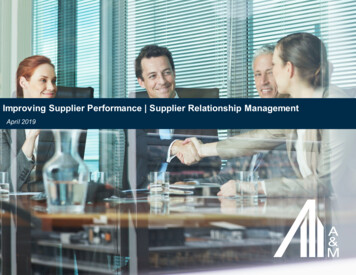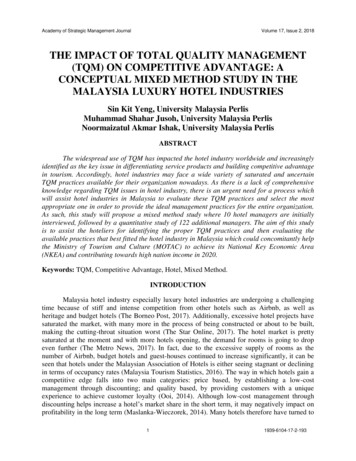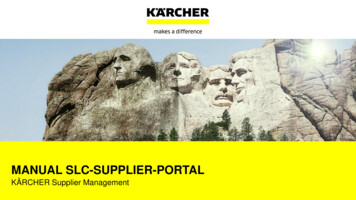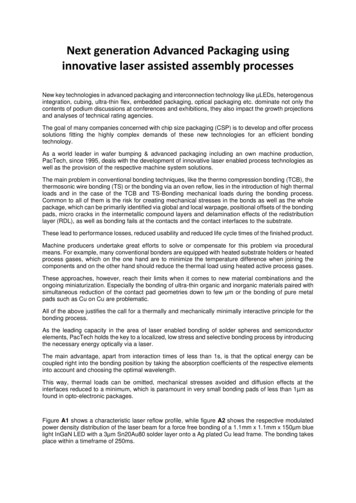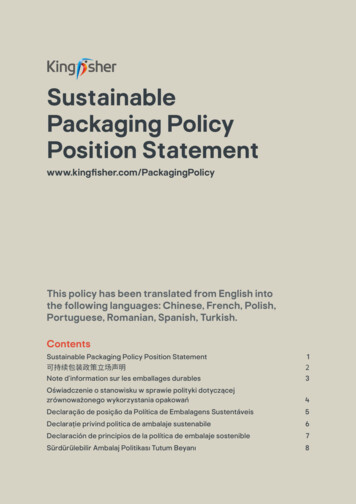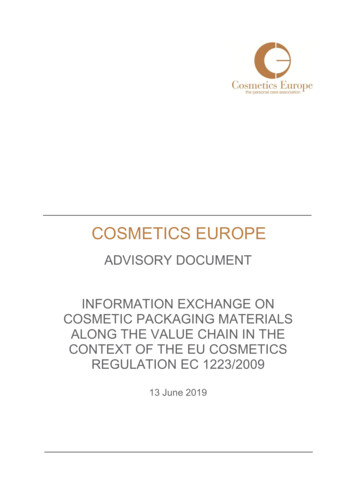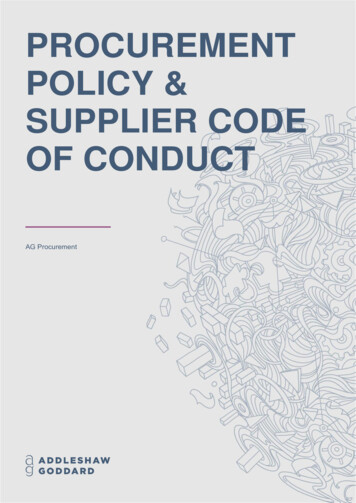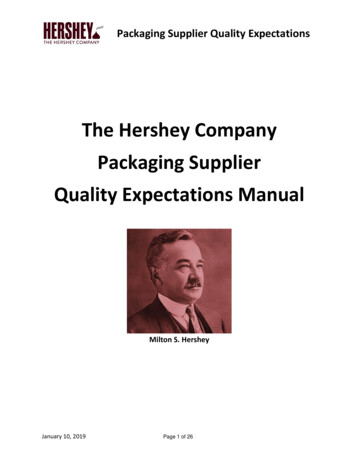
Transcription
Packaging Supplier Quality ExpectationsThe Hershey CompanyPackaging SupplierQuality Expectations ManualMilton S. HersheyJanuary 10, 2019Page 1 of 26
Packaging Supplier Quality ExpectationsAbout The Hershey CompanyA century ago, all we had to offer was a simple kiss. Today, we are among the most respectedcompanies in the world, bringing snacks, community growth, and human opportunity to all corners ofthe globe.It started with Milton Hershey, founder of The Hershey Company. He was not immediately successfulas a businessman, but he persevered through several failed attempts to start a confectionery businessbefore he established the Lancaster Caramel Company. In 1893, after visiting the World’s ColumbianExposition, Mr. Hershey became very interested in milk chocolate. Through trial and error, he finallyestablished his own formula for milk chocolate. In 1903, he returned to Derry Church, now known asthe town of Hershey, to begin construction of the original chocolate factory located at 19 EastChocolate Avenue. By 1905 the factory was complete and in production. The foundation and history ofThe Hershey Company are firmly grounded on the innovation and persistence of Milton Hershey.In addition to establishing a viable and growing business, Milton Hershey also provided a model ofsocial responsibility for other businessmen and his successors to follow. Along with building a factory,Milton Hershey set out to establish a town for his workers that went beyond basic housing to includeopportunities for entertainment and recreation. He is credited with building Hershey Park, a swimmingpool, and a ballroom. Later, as the depression took grip on the country, Mr. Hershey started the “GreatBuilding Campaign” to provide jobs. This effort yielded some of the town’s most prestigious buildingslike The Hotel Hershey, the community center, and the stadium to firmly entrench Hershey as adestination town for tourists.Along with establishing a town with all the amenities, Milton and Catherine Hershey founded theHershey Industrial School in 1909. Unable to have children themselves, they channeled their wealth tothe school, established for the care of orphaned boys. In 1918, Mr. Hershey gave his entire fortune of 60 million dollars to the school. Today the school has expanded to serve both girls and boys. TheMilton Hershey School is now home to over 2000 students from disadvantaged situations providingthem with housing, education, medical and dental care, opportunities for recreation, and the hope of afuture without poverty.The Hershey Company is over one hundred years old and proudly bears the name of its founder. Thecompany has grown from a single factory in Hershey, Pennsylvania to become the largest producer ofchocolate in North America and a global leader in confections. Hershey’s presence in the marketplaceis significant with over 80 global brands that are manufactured by facilities across the United Statesand the world.Continuing the legacy of our founder, Milton Hershey, our commitment to delivering quality productsto customers and upholding ethical business practices is core to who we are. We strive to make sure allof our decisions - from responsible sourcing of our ingredients and environmental stewardship tofostering diverse work environments and transparency - are guided by our deeply held values.“Give them quality. That’s the best kind of advertising in the world. ”Milton S. HersheyJanuary 10, 2019Page 2 of 26
Packaging Supplier Quality ExpectationsTABLE OF CONTENTSPage1.02.03.0INTRODUCTION1.1 Expectations1.2 Basic requirements1.3 Confidentiality1.4 Notifying Hershey of Significant Events5556QUALITY SYSTEM CONTROLS2.1 Hershey Audit/Inspection Requirements2.1.1 Hershey Standards2.1.2 Maintenance of Hershey Standards2.2 GFSI for Food Contact Packaging Suppliers2.3 QMS for Non-Contact Packaging Suppliers2.4 Internal Audit Program2.5 Regulatory Inspections and Audits2.6 Guaranty and Compliance2.7 Food Defense Program2.8 Testing Controls: Laboratory Requirements2.9 Testing Controls: Measuring & Monitoring Equipment2.10 Corrective and Preventative Action (CAPA)77778891010111111FACILITY ENVIRONMENT CONTROLS3.1 Good Manufacturing Practices (GMP)3.2 Personnel Training Program3.3 Employee Illness3.4 Facility Structure3.5 Utilities and Facility Services3.6 Equipment Design3.7 Equipment Maintenance Program3.8 Cleaning and Sanitation Programs3.9 Pest Management Program121313131414141516January 10, 2019Page 3 of 26
Packaging Supplier Quality Expectations4.05.06.0Production Process Controls4.1 Packaging Specification Requirements4.2 Certificates of Analysis4.3 Material Monitoring4.4 Hazard Analysis for Packaging Material Production4.5 Supplier Quality Management4.6 Inspection and Testing of Incoming Materials4.7 Traceability of Materials4.8 Allergen Management for Packaging Material4.9 Extraneous Matter Control for Packaging Material4.10 Control of Reworked Material4.11 Label Control4.12 Packaging Storage and Transportation4.13 Print Quality17171718181919192020212122Incident Management for Packaging Materials5.1 Hold and Release Control Program5.2 Material Retrieval and Recall Program5.3 Control of Non-Conforming Material222323General Material Requirements6.1 Supplier Information Form (SIF)6.2 Packaging Material Hazard Control6.3 Printed Material Management6.4 Transfer of Food Contact Material Constituents to Food23242424January 10, 2019Page 4 of 26
Packaging Supplier Quality Expectations1.0INTRODUCTIONThe Hershey Company Packaging Supplier Quality Expectations (SQE) Manual outlines the basicrequirements for suppliers for both contact and non-contact packaging applications. This manualapplies to any packaging materials for Hershey owned plants, co-manufacturers for Hershey, andco-packing companies acting on Hershey’s behalf.The expectations set forth in this manual are a minimum set of quality programs that should serveas a solid foundation for supplier quality management systems. The safety and quality of ourproducts are of the highest importance as are the trust and confidence of our consumers. TheHershey Company expects the same commitment to ensure food safety and quality systems byevery supplier.1.1. ExpectationsThe Hershey Company views suppliers as an extension of our company. Hershey strives forthe development of a relationship with our suppliers that will continually improve theproduct quality and safety that our customers and consumers demand. We rely on oursuppliers to embrace these programs and implement a culture that continually pursuesimprovements in food safety and quality to levels well above these minimum expectations.1.1.1.Each manufacturing location producing materials for The Hershey Company shallmeet the expectations in this manual. All records, communications, and certificationsshall be site specific to comply with this manual.1.2. Basic requirementsPackaging materials supplied to The Hershey Company shall comply with all applicable laws,regulations, and Codes of Practices and Standards of the production country and thedestination to which the materials will be delivered.1.2.1.Suppliers are solely responsible for operating their locations to comply withapplicable regulations and requirements of this manual. The Hershey Company mayestablish and/or modify specification processes, operating guidelines, andprocedures as industry, technology, and regulations change. This manual does notoutline or mandate how suppliers set up or operate facilities to meet theseexpectations.1.3. ConfidentialityThe contracts and agreements between The Hershey Company and suppliers shall governconfidentiality of shared information.The confidentiality provisions contained in contracts between the Hershey Company andsuppliers shall govern the disclosure of sensitive information shared between the companies.All personnel shall avoid sharing confidential or otherwise sensitive information unless such acontract is in place between the companies.January 10, 2019Page 5 of 26
Packaging Supplier Quality ExpectationsAuditors (Hershey or acting on behalf of the Hershey Company) shall not be asked orrequired to sign confidentiality agreements as a prerequisite to gain access for audits prior toor at any time during a quality audit. Auditors verifying compliance to The Hershey CompanySupplier Quality Expectation requirements will not audit or inspect financial data, sales data(other than that directly related to The Hershey Company), or pricing data. Auditors shall notinspect personnel data, other than data relating to qualifications or training of technical andprofessional personnel performing functions pertinent to the audit.1.4. Notifying Hershey of Significant EventsCommunication is critical when food safety or quality events occur. Suppliers shall establishprocedures to ensure Hershey and all other customers are properly notified of significantevents.1.4.1. Hershey shall be notified of the following instances:1.4.1.1.1.4.1.2.1.4.1.3.1.4.1.4.A quality or process deviation that could lead to recallDefective or adulterated materialsNon-routine regulatory investigationsRegulatory testing, sampling, reporting, or other contact that may affectmaterial used in the production of Hershey products1.4.1.5. Inadvertent release of hold material1.4.1.6. Suspected non-conforming material already shipped1.4.1.7. known or suspected product tampering1.4.1.8. An event that could threaten product security1.4.1.9. Changes to processes or facilities that could impact the material quality orsafety for intended use1.4.1.10. Inability to deliver materials that meet Hershey specifications1.4.1.11. Any other quality or business event impacting product performance ordelivery1.4.2.2.0Suppliers shall notify Hershey supplier relationship managers by both email andphone with a live person (no voicemail). It is vitally important that communication isquick, detailed, and documented to protect consumers and brand integrity.QUALITY SYSTEM CONTROLSSuppliers to The Hershey Company shall have a written and implemented Quality ManagementSystem (QMS) to ensure material conforms to Hershey specifications, all applicable regulatoryrequirements, any local laws, and requirements in this SQE manual.The QMS shall be reviewed on a regular schedule and include internal audits to determine theeffectiveness of the program. The supplier shall maintain records of effectiveness of the QMS.Records shall include the name and location of the site, accurate date of the activity, andsignature/initials of the person conducting the activity. To ensure QMS adequacy, The HersheyCompany requires audits and certifications to occur as listed below.January 10, 2019Page 6 of 26
Packaging Supplier Quality Expectations2.1. Hershey Audit/Inspection RequirementsAll manufacturing locations producing packaging material for The Hershey Company shall beapproved by Hershey personnel and follow the audit requirements in this section. Thissection applies to new and existing suppliers of both food contact and non-contact packagingmaterial.2.1.1.Hershey StandardsThe Hershey Company shall perform an initial quality assessment of all packagingsupplier sites as part of the approval and onboarding processes. Suppliers shallcomplete corrective/preventive actions (CAPA) in a timely manner (supplier QMSschedule or agreed timeline) and document CAPA plans with verification by TheHershey Company.2.1.2.Maintenance of Hershey StandardsThe frequency of additional Hershey audits shall be determined by supplierperformance, risk assessment, QMS status, and other factors determined by TheHershey Company.2.2. GFSI for Food Contact Packaging SuppliersFood contact packaging material is defined as either direct or incidental depending on theproduct packaging configuration. Food contact materials refer to all components includingthose materials that are intended for direct contact with food products as well as thosewhere incidental contact is possible.2.2.1.Food contact suppliers shall have a certification from a GFSI-recognized scheme(www.mygfsi.com) for the production site(s) of food packaging. Suppliers shallprovide a copy of the audit report or executive summary with the current certificateto The Hershey Company as part of the initial approval and ongoing supplier qualityrelationship maintenance. For annual documentation, suppliers shall share annualcertifications and, as requested, reports to include non-conformances (NC’s) withcorrective/preventive actions against cited NC’s.2.2.2.Specific information on the applicable timeline for meeting GFSI requirements shallbe available from the Hershey Business and Quality Regulatory Compliance (QRC)partners. If a supplier is not GFSI certified, a detailed plan shall be provided to outlinespecific activities and milestones for achieving GFSI certification.2.2.3.Suppliers can determine which GFSI scheme and certifying body best fits their qualityand business practices. GFSI certifications are site-specific but supplier corporatepolicies may dictate which scheme and certifying body are preferred.2.2.4.Where suppliers do not have a GFSI certification, the Hershey Quality SystemsAssessment shall be conducted as a basis to determine site quality programadequacy for use or temporary waiver.January 10, 2019Page 7 of 26
Packaging Supplier Quality Expectations2.2.4.1.A timeline for GFSI implementation shall be provided by the supplier.2.2.4.2.If a supplier site cannot comply within the GFSI implementation timeline,the location shall be placed in a status of “conditionally approved”. Thisstatus shall be considered approved for business use to ensure continuitybut on a watchlist by Hershey Supplier Quality. Hershey conditionalapproval may be revoked at any time.2.2.4.3.Conditionally approved sites shall be reviewed by Hershey management forcurrent and future use. This review shall be a risk-based assessment forfood safety, an evaluation of supplier quality performance, and adetermination of current quality systems effectiveness.2.2.4.4.If no plans are made for compliance, the supplier site may be moved to“suspended” status after one year of conditional approval. Suspendedsupplier sites shall not provide packaging materials for Hershey products.2.3. QMS for Non-Contact Packaging SuppliersNon-contact packaging is defined as neither contact nor incidental contact. Non-contactmaterial suppliers shall have a third-party quality management system (QMS).2.3.1.GFSI certification is an acceptable audit scheme for non-contact packaging supplier.2.3.2.Other adequate certifications and third-party quality management systems (QMS) fornon-contact supplier sites include but are not limited .2.3.2.7.2.3.3.Where suppliers do not have a third-party QMS certification, a Hershey QualitySystems Assessment shall be conducted as an initial audit. A timeline for QMSimplementation shall be provided during the onboarding process.2.3.3.1.January 10, 2019ISO 22000ISO 9001NSF Supplier Assurance Audit for packaging suppliersAIB Standards for Food Contact Packaging Manufacturing FacilitiesGMA-Safe/QMI-SAI GlobalWhen paired with QMS, BS EN 15593 Management of hygiene in theproduction of packaging for foodstuffsOther GMP/HACCP programs against a set third-party standard andexternal audit program with Hershey review and approvalIf a supplier site cannot comply within the QMS implementation timeline,the location shall be placed in a status of “conditionally approved”. Thisstatus shall be considered approved for business use to ensure continuitybut on a watchlist by Hershey Supplier Quality. Hershey conditionalapproval may be revoked at any time.Page 8 of 26
Packaging Supplier Quality Expectations2.3.3.2.Conditionally approved sites shall be reviewed by Hershey management forcurrent and future use. This review shall be an evaluation of supplierquality performance, a determination of current quality systemseffectiveness and, as applicable, a risk-based assessment for food safety.2.3.3.3.If no plans are made for compliance, the supplier site may be moved to“suspended” status after one year of conditional approval. Suspendedsupplier sites shall not provide packaging materials for Hershey products.2.4. Internal Audit ProgramAs part of the supplier QMS, there shall be a program of internal auditing to ensure theeffectiveness of the quality management system and food safety plans.2.4.1.Internal audits shall happen frequently enough to ensure major QMS functions arereviewed for adequacy and continuous improvement. Audits should be performed bypersonnel from outside the area being evaluated.2.4.2.Audit records shall be maintained, and trends shall be reviewed on a scheduledictated by the supplier’s QMS standards or more often as determined byperformance. Any corrective actions from internal audits shall be checked foreffectiveness and closed within a reasonable timeframe. Closure for audit nonconformance shall also include preventive actions to ensure solutions are in place toprevent recurrence in similar processes.2.5. Regulatory Inspections and AuditsSuppliers shall have strong tools and procedures to ensure compliance with the laws andregulations at the point of manufacture and in the country of sale of products.2.5.1.Written procedures and trained personnel shall be in place to manage regulatorycontacts and inspections.2.5.2.Suppliers shall keep records of all regulatory contacts, correspondence, visits, andinspections. These records shall include any issued reports, facility/companyresponses, and corrective actions with verification.2.5.3.The Hershey Company shall be notified of the status of any Hershey materialssampled or tested by regulatory authorities. If a regulatory organization samples amaterial produced for Hershey, the supplier shall contact Hershey for instruction. Thesupplier will also provide The Hershey Company with samples from the same lot asexamined by the regulatory contact. Hershey shall be notified of the status of anymaterials sampled or tested by regulatory authorities.2.5.3.1.January 10, 2019It is recommended that the lot be put on hold pending the closure of anyregulatory non-conformance or defect found during the initial sampling.Page 9 of 26
Packaging Supplier Quality ExpectationsProduct holds shall be implemented if there is any food safety orregulatory compliance concern.2.6. Guaranty and ComplianceSuppliers of food contact packaging shall complete a Hershey guaranty form (attached to thePackaging Supplier Information Form) during the site onboarding process or when providingnew materials. The Hershey Company shall only do business with suppliers that arecompliant with applicable packaging, food safety, and consumer safety laws and regulations.2.6.1.Suppliers shall guarantee and warrant that the materials comply with Hersheypolicies, Hershey-provided specifications, and intended use established by TheHershey Company during specification development. Conditions of use of thepackaging material shall be consistent with Hershey’s direction, specifications, andfinished product application.2.6.2.Supplier materials shall be fit for use in food packaging, and such materials, whenused to package foods will not render or cause such foods to be adulterated ormisbranded or prohibited from distribution and sale.2.6.3.Hershey may require a new guaranty form (Packaging Supplier Information Form) ifthe place of finished product manufacturing or marketing changes. Other changes forconditions of use, Hershey’s intended use, and changed export status of US productsmay also require a new guaranty form completion.2.6.3.1.The Hershey Company shall notify suppliers when a new guaranty orinformation form is required.2.6.4.Supplier-provided letters of guaranty and compliance will be accepted for Hersheyquality recordkeeping but are subordinate to the Hershey guaranty form, serviceagreements, or purchase order requirements.2.6.5.The Hershey Company reserves the right to verify guarantees through testing ofprovided materials.2.7. Food Defense ProgramFood contact packaging suppliers shall have specific site procedures to secure materials,prevent intentional contamination, and have controls to recognize/contain threats. Noncontact packaging suppliers should have similar programs to ensure the security of theirfacilities, materials, and finished products.2.7.1.At a minimum, supplier food defense programs shall contain the following:2.7.1.1.2.7.1.2.2.7.1.3.January 10, 2019A documented plan detailing the site’s procedures and strategies.Clearly defined roles and responsibilities for the programProcedures for reporting threats to The Hershey CompanyPage 10 of 26
Packaging Supplier Quality Expectations2.7.1.4.2.7.1.5.2.7.1.6.2.7.1.7.Annual self-assessments for vulnerability and program effectivenessAccess control for manufacturing areas, raw materials, chemical storage,shipping, and receivingPrograms to verify incoming materials and outgoing shipmentsProcedures for maintenance of records for raw materials andmanufacturing2.8. Testing Controls: Laboratory RequirementsSuppliers shall ensure that testing and monitoring personnel have access to all necessaryinformation such as laboratory methods manuals, specifications, test requirements, andlaboratory procedures to carry out their responsibilities with respect to materials producedfor The Hershey Company.2.8.1.Testing and monitoring programs shall be based on generally recognized methods ortest methods that have been approved The Hershey Company.2.8.2.Supplier laboratories and laboratory personnel shall comply with Good LaboratoryPractice requirements – retained samples, traceability of lab standards, controlledchemicals, control of sensitive materials, and restricted personnel access.2.9. Testing Controls: Measuring & Monitoring EquipmentSuppliers shall have a written process to inspect, test, and calibrate measuring andmonitoring equipment. The process shall ensure the precision and accuracy of the equipmentto be consistent with the measurement requirements.2.9.1.Calibration shall be against a recognized standard which are traceable tointernational or national measurement standards. Where no such standards exist,the method of establishing and maintaining the standard for calibration shall bedocumented. Calibration checks shall be documented and records shall bemaintained in accordance with the manufacturing site or supplier corporate policies.2.9.2.Calibration procedures shall exist for each piece of measuring and monitoringequipment to include minimum tolerances, corrective action plans when out ofcalibration, name of the equipment and a unique identifier, location, method andfrequency of calibration, and responsible personnel.2.9.3.Product that may have been affected due to equipment being out of calibration shallbe evaluated and dispositioned.2.10. Corrective and Preventative Action (CAPA)All programs mandated by the supplier’s QMS and this manual shall require that Correctiveand Preventive Actions (CAPAs) be taken in the event of non-conformances. The CAPAtracking program shall be in place for documentation, timeliness tracking of actions taken,and verification of effectiveness. CAPA tracking shall cover internal issues and audits,regulatory and external audits, material supplier quality, and customer feedback.January 10, 2019Page 11 of 26
Packaging Supplier Quality Expectations2.10.1. The CAPA program shall include an adequate and unique identification of the nonconformance, root cause analysis documentation, an action item list (who does whatby when), closure dates, verification of effectiveness with objective evidence, andperiodic review by the management team.2.10.2. Logs, records, and other CAPA documentation shall be made available to TheHershey Company for materials intended for Hershey use.3.0FACILITY ENVIRONMENT CONTROLS3.1. Good Manufacturing Practices (GMP)Food contact packaging suppliers shall comply with GMP requirements, tailored to theiroperation and facilities, to ensure food safety of all products supplied to The HersheyCompany. All persons entering the supplier facility shall comply with GMP requirements.GMP requirements shall be in writing and available to all personnel.Suppliers shall review and update GMP requirements on a periodic basis. The GMPs shalladdress personal practices, handling and storage of equipment and materials, propercleaning and sanitation, and receiving. Any programs shall follow applicable regulatoryrequirements and supplier QMS for the manufacturing location. Suppliers for non-contactpackaging shall maintain cleaning standards to ensure adequate material safety and quality.3.1.1.The following are not permissible in GMP areas:Eating or drinking, chewing gum, candy, lozenges, tobacco, false eyelashes, fingernailextensions, fingernail polish, rings (other than wedding band without stones),watches, earrings, necklaces, piercings, or other jewelry.3.1.2.If allowed on the supplier premises, smoking shall be in designated locations awayfrom GMP areas and outside building confines. Employees shall wash their handsbefore returning to GMP areas from these smoking locations.3.1.3.Employee meals shall be stored and consumed in designated areas only, away fromGMP areas. Pest management shall include food storage and consumption areas.3.1.4.Clothing and shoes shall be company approved and kept in good repair. Clothing shallprovide adequate coverage to ensure product protection from hair, perspiration, andother foreign materials. Personal protective equipment (PPE) shall be maintained forfunctionality and cleanliness. PPE shall be designed to prevent productcontamination.3.1.5.Personnel shall wash their hands before entering the GMP areas, after rest roomvisits, after eating, after smoking, and when hands have become soiled. Minor handcuts shall be protected and sealed from possible product contamination. Clean,January 10, 2019Page 12 of 26
Packaging Supplier Quality Expectationssanitary gloves shall be worn in any GMP areas when touching food contactpackaging or product contact surfaces are present.3.1.6.Hair shall be confined by hairnets and cover the ears. Beard nets shall be used ifemployees are not clean shaven. If safety helmets are required, they shall be wornover hair restraints.3.1.7.Material storage shall be off the floor and walking surfaces. Product, raw materials,and rework shall be protected and stored in a sanitary manner. Finished, rework, andraw materials shall be labelled with name and lot number for traceability purposes. Ifmaterial is stored vertically (e.g. warehouse racks), food contact material shall alwaysbe stored above non-food grade material.3.2. Personnel Training ProgramSuppliers shall ensure all employees receive appropriate job training to include GMP duringorientation and defined intervals. Records of training and refresher shall be maintained bythe supplier. The training program shall be periodically evaluated for effectiveness throughinternal audits or methods identified in the supplier QMS.3.3. Employee IllnessThe supplier shall establish procedures which cover the handling of employee illnesses. At aminimum, no person shall be admitted into a GMP area if they are a potential source ofmicrobial or viral contamination.3.4. Facility StructureSupplier manufacturing facility shall be constructed to ensure production of safe and highquality materials. Facility grounds shall be maintained to address food defense and pestmanagement. The location and design of waste bins, toilets, and hand washing shall beadequate to comply with GMPs and other sanitary requirements.3.4.1.Manufacturing and storage structures shall be free of cracks and holes to preventpest and environmental contaminants.3.4.2.Floors, walls, and ceiling shall be cleanable. All surfaces shall made to resistdeterioration, flaking, or moisture retention.3.4.3.Laboratories shall be separate from the production areas. Chemical andmicrobiological testing areas may require additional isolation.3.4.4.The location and number of handwashing and sanitizing stations shall be adequatefor the number of employees at the site. Sinks for handwashing and processing shallbe separate. Restrooms shall include functional handwashing and drying stations.Restrooms shall not have direct access to GMP areas.January 10, 2019Page 13 of 26
Packaging Supplier Quality Expectations3.5. Utilities and Facility ServicesFood contact packaging suppliers shall have programs in place to ensure utilities do notcompromise GMP area conditions. Utility services include environmental air, compressed air,steam, air and centralized systems. Utility control shall have controlled access for onlyauthorized personnel. All systems shall be periodically checked, tested, and maintained.3.5.1.Environmental air shall be monitored to prevent contamination from potentialmicrobiological and physical contaminants. Process air (air systems directly used inmaterial production) shall be food grade, free of oil, and filtered. Air filters shall beinspected and replaced on a periodic basis.3.5.2.Potable water systems shall meet all local and national regulations. The site shall testand control water quality used in processing.3.5.3.Steam used in processing shall be clean and free of contaminants. Only food gradechemicals shall be used in boilers that provide processing steam.3.5.4.Utility chemicals that are not in use shall be stored in controlled areas. Controlledareas shall be locked, and only authorized personnel should have access.3.6. Equipment DesignFood contact packaging suppliers shall ensure that equipment design is adequate to producefood contact materials that meet food safety and quality parameters. Piping and ducting shallbe insulated where condensation might occur. Insulation shall be maintained to preventdeterioration or loose materials. Non-contact packaging suppliers shall ensure thatequipment design ensures product quality and adhe
4.8 Allergen Management for Packaging Material 19 4.9 Extraneous Matter Control for Packaging Material 20 4.10 Control of Reworked Material 20 4.11 Label Control 21 4.12 Packaging Storage and Transportation 21 4.13 Print Quality 22 5.0 Incident Management for Packaging Materials


